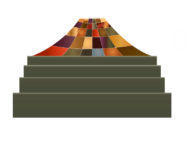Palm Sunday

The procession of palm branches most likely began in the 3rd or 4th century CE (common era) by the churches in Jerusalem (Francis Mershman, Catholic Encyclopedia, 1911). It marks the beginning of Holy Week, as Christians remember or relive Jesus’ entry into Jerusalem riding a donkey and other aspects of Jesus’ story in the last days.
Before Palm Sunday, it is still possible that Jesus will stop his journey to Jerusalem and skip the confrontation with the social, religious, and political orders. All the gospels contain a version of the story (Matthew 21, Mark 11, Luke 19, and John 12). Many congregations ask the children and youth to lead the procession of palms (and perhaps hand them out to adult members) during the opening hymn. I have always found this curious and wondered why this is how the church chooses to include the children on Palm Sunday. Is it how the church re-enacts, “and a little child shall lead them” (Isaiah 11:6)?
Many traditions associated with Palm Sunday have developed over the centuries. Some congregations bless the palms before the procession; many collect some of the palms after worship to keep to burn for the following year’s Ash Wednesday service; and some teach the children how to fold the palms into a cross.
Whatever tradition you follow, this may provide the content for a children’s sermon about Palm Sunday. One could ask the children if there is anything different happening in worship this morning and then talk with the children about why your congregation recognizes Palm Sunday. If you created a liturgical calendar or graphic for the children to help them understand the movements of the “Christian” year, this would be a good time to bring that to the sacred steps as you talk about Palm Sunday and Holy Week.
- The children probably have heard bits and pieces of this psalm during their lives: as part of the call to worship, in prayers, and in hymns. One might consider highlighting the verses from this psalm and talking with the children about how your congregations read or pray the psalms as part of worship.
- One might introduce the children to the Hebrew word, hesed (see below), and talk with them about what this word means. As the adult leader, you might talk about how you have experienced God’s hesed or have a member or two of the youth group (or some adults in the congregation) ready to briefly say how they have experienced God’s hesed.
- Create a “God’s hesed” banner that the children could draw or write on while you talk with them about God’s love for humanity.
- If you created an “Images of God” poster to use with the children, this would be another time to bring that out and add images of God that reflect the concept of hesed to the list. You might use Hosea’s image of God as a mother bear.
This Hebrew word, hesed, is usually translated as “steadfast love” and is primarily used in the Hebrew Bible to describe God’s attitude toward humanity. The typical English translation, though, does not quite express the depths of this kind of emotion. This is a fierce and relentlessly protective love that God feels for humanity. In the imagery of Hosea, God’s love is like that of a mother bear robbed of her cubs (Hos 13:8). Rev. Dr. Lisa Davison.
- Many will retell the story of waving palms and coats during the children’s sermon. If you choose to do this, it would be helpful to talk with the children about the journey of Lent (the last 40 days) and how we have followed Jesus to this moment when he enters Jerusalem. Today, we remember that, after a long journey, Jesus and the disciples entered Jerusalem. If you have an older group on the sacred steps, you could talk with the children about Jesus’ traveling to Jerusalem to celebrate the Passover feast, the day when Jewish people remember that God led their ancestors out of Egypt. Passover helps Jewish people remember an important part of their story. Many things will happen this week to Jesus and the disciples that help Christians remember something about our story and the faith of our ancestors.
- Why palm branches and coats? This is an opportunity to talk with the children about how the ancient world recognized leaders. Children will have probably seen a parade as a celebration. Jesus’ entry into Jerusalem was a parade of sorts, as the peasants and his followers welcomed him in the way they would any important leader.